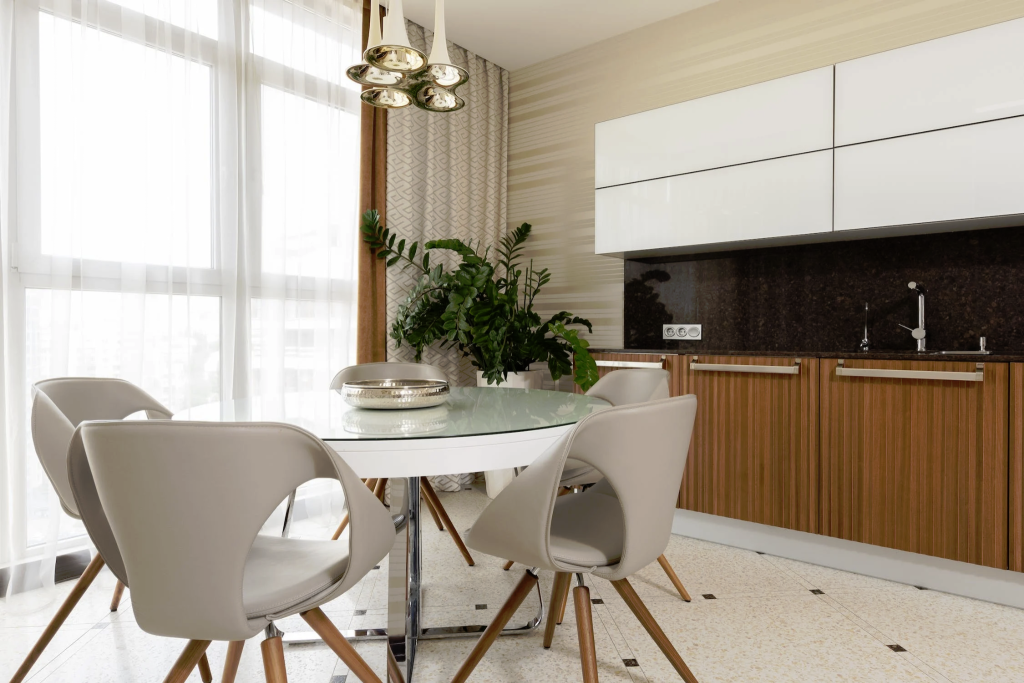Your kitchen flooring takes a lot of punishment, so you need to make sure that the material it’s made of is up to the task of surviving years of wear and tear, and looks good while doing it.
There are three main options to consider here, but what does each offer, and how will your budget be impacted by your choice?
The Benefits of Tile Floors in the Kitchen
Tile floors offer a variety of benefits for your kitchen space. They are highly durable, easy to clean and maintain, water-resistant, and come in many different styles and colors. With proper installation techniques you can expect tile flooring to last up to 25 years or more.
Tiling is also relatively inexpensive compared to other types of flooring materials like hardwood or stone, making it an economical choice for budget-conscious homeowners.
Additionally, tiles provide a high level heat resistance, which makes them perfect for kitchens that get plenty of foot traffic during meal preparation times.
Lastly, tiled surfaces are non-porous, so they won’t absorb grease splatters from cooking activities as easily as other materials like linoleum might do over time.
How Much Will Tiling Cost?
When considering the cost of tiling your kitchen, it is important to factor in both the material and labor costs. The type of tile you choose will affect the overall price as well, as ceramic tiles tend to be more affordable than porcelain or stone tiles, but may not last as long.
Labor costs for installing a tile floor also vary depending on how large your project area is, and what kind of pattern or design you want. Generally speaking, professional installation can range anywhere from $1-$15 per square foot depending on these factors.
It’s always best to get several estimates before making any decisions about who should do the work for you, and choose a contractor that provides accurate tile quotes to avoid any unexpected expenses or overspending incidents.
Pros and Cons of Vinyl Flooring
Vinyl flooring is an inexpensive option for kitchen floors, and benefits from being available in a bevy of different designs. It’s also very easy to maintain, won’t wear down too quickly in this busy part of the home, and has the added benefit of being softer underfoot than tile or linoleum.
The downside is that it can be difficult or even impossible to repair if it gets damaged over time due to its plastic composition. So from a sustainability perspective, it is harder to recommend.
Also, vinyl may not hold up as well in areas where there are high levels of moisture present, such as near sinks or dishwashers, so you should take this into consideration when deciding which type of flooring material is best for your kitchen space.
What is Linoleum and Is It Right for Your Kitchen?
Linoleum is another popular material used in kitchen flooring. It’s made from natural materials such as linseed oil, cork dust and wood flour, making it eco-friendly.
In terms of cost, linoleum tends to be more expensive than vinyl, but less pricey than tile or stone options.
On the plus side, it can hold up well against scratches and scuffs due to its resilient nature, while also being quite easy to clean with just soap and water.
However, the drawback of this type of flooring material lies in its tendency to fade over time when exposed to direct sunlight or high humidity levels, which may make it a less ideal choice depending on your local climate.
Maintenance Tips for Each Type of Flooring Material
Each type of flooring material requires different levels of maintenance in order to stay looking its best for years to come.
Vinyl floors are easy to clean and maintain with just a regular sweeping, mopping or vacuuming routine. This could be a selling point if you’ve got a busy schedule.
Linoleum needs more care however, so it’s important to regularly mop the surface using warm water and mild soap every few weeks in order to prevent dirt build-up which can cause discoloration over time.
Tiled surfaces should be sealed at least once a year as well in order to protect them from water damage, while also making them easier to wipe down after spills or messes occur. This isn’t true for every tile type, as kitchen-specific products can be extremely resilient, so it’s a case of getting expert advice and choosing carefully to minimize maintenance needs here.
The Bottom Line
Creating a kitchen floor that’s right for you is about combining your budget with your aesthetic sensibilities as well as your ethics, and coming up with the answer that ticks all the boxes. Paying a pro to install the flooring material you choose also makes sense, but shop around for the best quote before committing.

